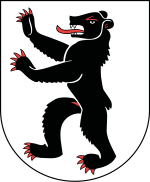|
Pizzle
 Pizzle is a Middle English word for penis, derived from Low German pesel or Flemish Dutch pezel, diminutive of the Dutch language pees, meaning 'sinew'.[1][2] The word is used today to signify the penis of an animal,[3] chiefly in Australia and New Zealand.[4] The word pizzle is also known, at least since 1523, especially in the combination "bull pizzle", to denote a flogging instrument made from a bull's penis. In William Shakespeare's play Henry IV, Part 1, the character Falstaff uses the term as an insult (Act 2, Scene IV):[5]
In heraldry In heraldry, the term pizzled (or vilené in French blazon)[6] indicates the depiction or inclusion of an animate charge's genitalia, especially if colored (or "tinctured") differently.[7] In 1485, Henry VII carried with him a red dragon with an erect pizzle on the field of Bosworth where he was declared King of England.  The bear in the coat of arms of Appenzell is represented pizzled, and omission of this feature was seen as a grave insult. In 1579, the pizzle was forgotten by the printer of a calendar printed in Saint Gallen, which brought Appenzell to the brink of war with Saint Gallen.[8][9][10]  In 2007, commander Karl Engelbrektson decided that the lion's penis in the coat of arms of the Nordic Battlegroup had to be removed.[11] Contrary to initial media reports that the decision was taken following complaints from female soldiers, Engelbrektsson revealed in a February 2008 interview with Sveriges Radio that it was he who made the decision, based on the 2000 United Nations Security Council Resolution 1325 on women, peace, and security.[11] Since civilian women are often sexually assaulted in the war zones of the world, the commander did not consider the depiction of a penis appropriate on a uniform worn into battle.[11] The decision was questioned by some Swedish heraldists, with Vladimir Sagerlund asserting that coats of arms containing lions without a penis were historically given to those who had betrayed the Swedish Crown.[11] The state heraldist Henrik Klackenberg complained that his heraldry unit should have been consulted before making such change, but did not intend to take legal action.[11] Modern usesParamilitary use in World War IIPizzles were widely used (as whips) as late as 1944 by local paramilitary units on the Eastern Front, usually as a disciplinary measure against arrested or bullied civilians.[12] Animal consumptionPizzles, or bully sticks, are mostly produced today as chewing treats for dogs.[3] Bull penises are dried, in open air or in ovens. Commercial vendors will drain the blood and urine from the organ prior to drying in order to decrease the smell of these when chewed by dogs. These are called "odor free" bully sticks. "Junior" bully sticks are thinner ones that are made from castrated males (steer).[13] GlueThe pizzle of bull was commonly rendered for use as glue between the 40s and the 60s.[14] Human consumptionIn addition to being used as a dog treat, pizzles are also eaten by humans for their purported health benefits (according to traditional Chinese medicine) such as being low in cholesterol and high in protein, hormones, and vitamins, and minerals such as calcium and magnesium,[3] although little empirical evidence supports these claims. Pizzles for human consumption are prepared either by freezing or by drying. Scottish deer pizzles are thought to boost stamina and were used by Chinese athletes at the 2008 Summer Olympics.[3][15] Pizzles can be served in soup, and if they have been dried they can be turned into a paste. Pizzles may also be mixed with alcoholic beverages or simply thawed (if frozen) and eaten.[3] In Jamaica, bull pizzles are referred to as "cow cods" and are eaten as cow cod soup. Like many animal penis- or testicle-based foods, cow cod soup is claimed to be an aphrodisiac and to be able to boost muscle strength. CanesA semi-novelty use for bull's pizzles is in the manufacture of walking sticks. They are reinforced with a metal rod down the center, cured by a taxidermist until fully dried, lacquered, then fitted with a handle and ferrule, closely resembling wood when finished. Though mostly produced from domestic cattle, pizzles from bison are also sometimes used. The use of pizzles as canes dates to as far back as Ancient Egypt, and more recently, legends such as Doc Holliday, Bat Masterson, and Jack Dempsey owned pizzle canes.[16][17] References
|
